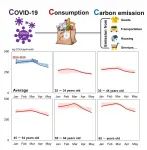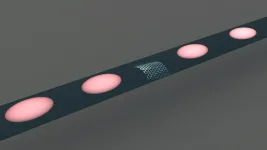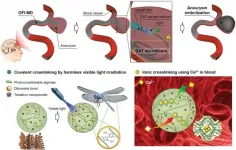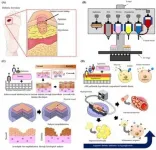(Press-News.org) The Covid-19 pandemic, like many other health crises, has had unequal effects on the U.S. population, with communities of color often hit the hardest. A new study co-authored by an MIT professor identifies a related challenge: Different social groups have different reactions to the fact that Covid-19 has generated those health inequities.
More specifically, the study, based on a multilayered survey of U.S. residents, finds a divergence among racial groups when people are informed about the varying effects of the pandemic. Upon learning more about the social distribution of Covid-19, Black Americans tend to gain a better understanding of their risk. But among white Americans given the same information, there is a split response.
The study used "feeling thermometers," on a scale from 0 to 100, to let participants rate their attitudes towards other racial groups. After learning more about health disparities, whites with "warmer" feelings toward Blacks favored a more vigorous public health response, while those with a "cooler" view of Blacks subsequently viewed Covid-19 as a less urgent problem and became less inclined to support strong public health measures.
"From a public health perspective, there is both good and bad news," says MIT political scientist Evan Lieberman, co-author of a new paper detailing the study's results. "For African Americans who were learning from this study that death rates were higher among African Americans, this increased their perception that they were at greater risk from Covid. ... That's good news because a big part of public health messaging is to make people aware of these dangers."
Moreover, Lieberman adds, "A second piece of good news is that a large share of white Americans feel empathic or close to Black Americans." And those fitting this description "became more invested in the notion that the government should do more on Covid."
However, white participants who admitted to having colder feelings about Blacks became more reluctant to support extensive efforts to tackle the pandemic.
"We did find that those whites who had these cooler views toward African Americans, to the extent they were aware of these disparities in death rates, were more likely to perceive that this was not a problem that affected them, and wanted less aggressive action on Covid-19," says Lieberman.
The paper, "How information about race-based health disparities affects policy preferences: Evidence from a survey experiment about the COVID-19 pandemic in the United States," is published in the May issue of the journal Social Science and Medicine. The authors are Lieberman, who is the Total Professor of Political Science and Contemporary Africa at MIT; and Allison Harell, a professor of political science at the University of Québec at Montréal.
To conduct the study, the researchers conducted an online survey from August to September 2020, using the Qualtrics platform and working with the survey firm Dynata. The final sample is a demographically representative group of 3,961 adult Americans. The participants were asked a variety of questions, and responded to the "feeling thermometers" about other racial groups.
Some participants were then given information about the health disparities generated by Covid-19 -- as of last summer, there were 2.5 times as many deaths per capita for Black Americans, compared to white Americans. Then respondents were asked a series of follow-up questions about Covid-19 risk, the government reaction, public health measures, personal liberties, and economic relief measures.
Only about 15 percent of the whites in the survey reported an unfavorable view about Blacks generally. But among those who did, there was a significant shift in perspective after being presented with information about Covid-19 health disparities. Those least favorable toward Blacks were most likely to think the government was doing too much to combat Covid-19 for instance, while those more favorable were most likely to think the government was doing too little. The researchers identified a similar pattern related to acceptance of certain public health measures such as social distancing and restricting access to public venues.
"It was telling that this share of participants, when they learned this information, became disinclined to have a public health response to Covid," Lieberman says. "Whites who were cool toward Blacks at the start of the study were already relatively less inclined to support aggressive Covid policies. So, the overall effect of receiving the information was to further polarize attitudes on this important set of policies."
Moreover, he says, the results are of a piece with other findings indicating that, for instance, white American men disproportionately do not want to get vaccinated.
"That's a clear expression of a denial of the problem and a lack of interest in participating in what needs to be a coordinated effort to achieve herd immunity," Lieberman says. "They're not interested in a multiracial collective [solution], nor do they perceive themselves to be particularly vulnerable."
Lieberman and Harell recognize their findings can seem vexing, since health officials place a premium on delivering facts to the public -- and in this case, the facts can lead a portion of the population to become more indifferent to the problem. Still, Lieberman says, the research could help make public health messaging more effective.
"The best strategy would be some targeting in messaging," Lieberman suggests. Communicating the facts about Covid-19 disparities usefully informed Black participants, after all, while for some others, he says, it may be necessary to attempt "more messaging that reminds us of the different ways we're interconnected, in which we all lose out to the extent that this pandemic persists."
Reformulating a certain amount of Covid-19 messaging may not be easy. Still, Lieberman says, even if policymakers "are uncomfortable with the notion that there might be any negative effects of disseminating true information, it's fairly clear that's an important reality."
INFORMATION:
The study was supported, in part, by the Canadian Institute for Advanced Research.
Additional background
Paper: How information about race-based health disparities affects policy preferences: Evidence from a survey experiment about the COVID-19 pandemic in the United States"
https://www.sciencedirect.com/science/article/pii/S0277953621002161?via%3Dihub
Australian photovoltaics researchers have made a 'cool' discovery: Singlet fission and tandem solar cells - two innovative ways to generate solar power more efficiently - also help to lower operating temperatures and keep devices running for longer.
Tandem cells can be made from a combination of silicon - the most commonly used photovoltaics material - and new compounds like perovskite nanocrystals, which can have a larger bandgap than silicon and help the device to capture more of the solar spectrum for energy generation.
Singlet fission, meanwhile, is a technique that produces twice the electronic charge carriers than normal for each photon of light that's absorbed. ...
A chemical that the NSW government has recently partially banned in firefighting has been found in the pups of endangered Australian sea lions and in Australian fur seals.
The finding represents another possible blow to Australian sea lions' survival. Hookworm and tuberculosis already threaten their small and diminishing population, which has fallen by more than 60 percent over four decades.
The new research - part of a long-term health study of seals and sea lions in Australia - identified the chemicals in animals at multiple colonies in Victoria and South Australia from 2017 to 2020.
As well as in pups, the chemicals (Per- and polyfluoroalkyl substances - 'PFAS') were detected in juvenile ...
Despite the rapid and significant changes in consumption patterns witnessed during the initial months of the COVID-19 pandemic, Japanese households maintained their normal levels of greenhouse gases emissions. The "anthropause" -- reduction of human activity due to the pandemic -- made headlines last summer, but factory shutdowns and broken global supply chains did not translate into the adoption of eco-friendly lifestyles for the average household.
"During the early COVID-19 period, we could witness lifestyle changes happening around us fast, so we decided to explore the environmental impacts of these lifestyle changes. Some other research at that period was showing that the production-side greenhouse gases emissions ...
The promise of a quantum internet depends on the complexities of harnessing light to transmit quantum information over fiber optic networks. A potential step forward was reported today by researchers in Sweden who developed integrated chips that can generate light particles on demand and without the need for extreme refrigeration.
Quantum computing today relies on states of matter, that is, electrons which carry qubits of information to perform multiple calculations simultaneously, in a fraction of the time it takes with classical computing.
The co-author of the research, Val Zwiller, Professor ...
Cerebral aneurysms are malformations caused by abnormalities on the walls of blood vessels in the brain. When these blood vessels rupture, about 30% of the sufferers die on the spot, giving these the rightful label of 'ticking bombs in the head'. Recently, a research team at POSTECH has come up with a new treatment that can disassemble these time bombs by filling the aneurysm in blood with a new method.
In order to overcome the shortcomings of coil embolization, POSTECH's joint research team (Professor Joonwon Kim and Dr. Jongkyeong Lim of the Department of Mechanical Engineering with Professor ...
The skin, which covers the surface of the human body, is its largest organ. It is the first organ to show changes stemming from organ or physiological activity. It is especially common for diabetic patients to suffer from skin diseases or infections. Recently, a POSTECH research team has succeeded in creating a 3D artificial skin that enables observation of skin diseases of diabetic patients.
A research team led by Professor Dong-Woo Cho and Minjun Ahn of POSTECH's Department of Mechanical Engineering and Professor Byoung Soo Kim of School of Biomedical Convergence Engineering at Pusan National University has ...
A decade already passed from the first use of bioresorbable vascular scaffold in percutaneous coronary interventions. The first studies - by using surrogate endpoints - showed some superiority of BRS vs. metallic drug-eluting stent in terms of the so-called vascular restoration therapy with recovery of vasomotion and vascular pulsatility when the scaffold was absorbed.
Nevertheless, after these first promising findings, larger and randomized clinical trials and subsequent meta-analyses, powered to hard clinical endpoints, showed that bioresorbable vascular scaffolds, made ...
Researchers at KU Leuven (Belgium) have developed a 3D printing technique that extends the possibilities of lateral flow testing. These tests are widespread in the form of the classic pregnancy test and the COVID-19 self-tests. With the new printing technique, advanced diagnostic tests can be produced that are quick, cheap, and easy to use.
The COVID-19 pandemic has made everyone aware of the importance of rapid diagnosis. The sale of self-tests in pharmacies has been permitted in Belgium since the end of March. This self-test is a so-called lateral flow test. Using a ...
Analysis of The Autopsy, Toxicological, and Psychiatric Reports of Portugal's First Major Forensic Case: Part III
https://doi.org/10.1080/20961790.2021.1898079
Announcing a new article publication for Forensic Sciences Research journal. In this review article the author Ricardo Jorge Dinis-Oliveira of the University Institute of Health Sciences (IUCS)-CESPU, Gandra, Portugal continues a three-part investigation of the "Crime of Flores Street" one of the most famous cases of poisoning which occurred in Portugal in the late 19th century. The case demonstrated the weaknesses of the Portuguese medicolegal system and attests to the importance of toxicological analysis. The first article ...
Most people who are infected with SARS-CoV-2 develop no or only mild symptoms. However, some patients suffer severe life-threatening cases of COVID-19 and require intensive medical care and a ventilator to help them breathe. Many of these patients eventually succumb to the disease or suffer significant long-term health consequences. To identify and treat these patients at an early stage, a kind of "measuring stick" is needed - predictive biomarkers that can recognize those who are at risk of developing severe COVID-19.
First biomarker to predict severity of disease
A team led by Professor Burkhard Becher at the Institute of Experimental Immunology at the University of Zurich, working with researchers from Tübingen, Toulouse and Nantes, has now discovered such ...






